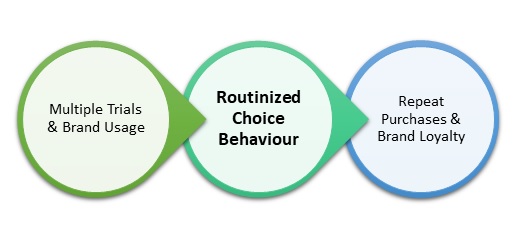- Business Concepts ›
- Marketing and Strategy ›
- Routinized Choice Behaviour
Routinized Choice Behaviour
Definition, Importance & Example
This article covers meaning & overview of Routinized Choice Behaviour from marketing perspective.
What is meant by Routinized Choice Behaviour?
Routinized choice behaviour or routinized response behaviour occurs after sufficient number of ‘trials’ or purchases of a particular brand. The decision to again buy the product requires little or no decision making as the routinized choice behaviour becomes habitual with each subsequent purchase. Routinized choice behaviour is a characteristic of being loyal to a brand as well.
With the rapid increase of promotion, the problem lies in measuring consumer response. An individual’s response to promotions is indicated by the extent to which promotions play a role in his or her purchase routine with respect to a brand.
Importance of Routinized Choice Behaviour
It is important for the marketers so that they avoid marketing related environmental interruptions such as stockouts that could force the loyal customers to try their competitor’s brand. In marketing, it is important to understand the consumer buying behaviour patterns to increase business and customer loyalty. The decision making process of customers has different levels i.e. extensive problem solving, limited problem solving and routinized choice behaviour.

Under routinized choice behaviour, customers think they know all they need to know about a product category, they don’t even search for new information about that product.
Then their choice is governed by learned decision plan stored in the memory. In such cases, appropriate marketing strategy depends on strength of brands position in the market. So, it is very important for the company to include its brand in choice alternatives from the very beginning. As once the customers get a routinized choice behaviour, its very difficult to influence their choice.
New brands or brands with low market share can develop strategies of producing prominent environmental stimuli such as large or unusual store displays, give away samples or provide attractive offers, etc. These strategies might catch the attention of the consumers and interrupt their routine behaviour.
Advantages of Routinized Choice Behaviour
1. Consumers stick to your brand irrespective of marketing promotion.
2. Companies avoid stockouts so that consumers don’t switch their brand
Disadvantages of Routinized Choice Behaviour
1. Matter of concern for other brands or new brands to establish itself in the minds of the consumers by influencing their choice.
2. Consumers become biased about their choices and mayn’t even try a new brand even if it is be better.
Example of Routinized Choice Behaviour
Let consider three consumers who purchases cup noodles from among brand A, B and C. Consumer 1 strongly prefers brand C and routinely buys C on every occasion as a routinized choice behaviour. He/she ignores promotional activities of all the three brands. Consumer 2 prefers both the brands A and C nearly equally. He/she uses the promotional activities of A and C to decide which brand to buy each time. Consumer 3 prefers the brands A and B nearly equally. He/she uses only the promotional activities of brands A and B only and not C to decide which one to buy each time.
Promotions by brand C do not affect their decision and choice behaviour of consumer 1 and 3. Promotion by brand C is effective in inducing a purchase for consumer 2. Each individual may respond differently to the promotions of each brand in a product class. So, the consumer’s routinized choice behaviour shows that consumers pay attention to the promotional activities of one brand while ignore that of the others.
Hence, this concludes the definition of Routinized Choice Behaviour along with its overview.
This article has been researched & authored by the Business Concepts Team which comprises of MBA students, management professionals, and industry experts. It has been reviewed & published by the MBA Skool Team. The content on MBA Skool has been created for educational & academic purpose only.
Browse the definition and meaning of more similar terms. The Management Dictionary covers over 1800 business concepts from 5 categories.
Continue Reading:
What is MBA Skool?About Us
MBA Skool is a Knowledge Resource for Management Students, Aspirants & Professionals.
Business Courses
Quizzes & Skills
Quizzes test your expertise in business and Skill tests evaluate your management traits
Related Content
All Business Sections
Write for Us